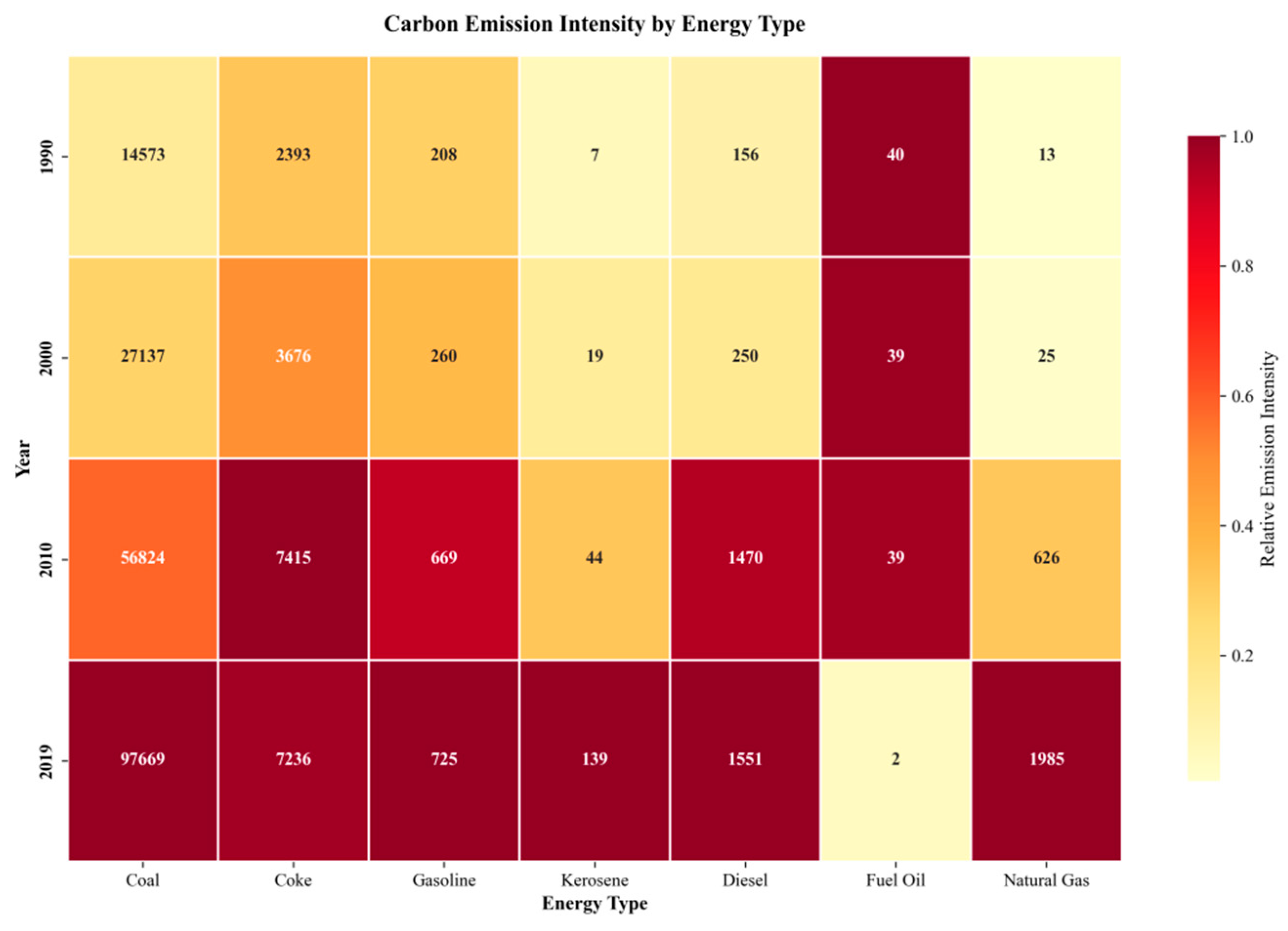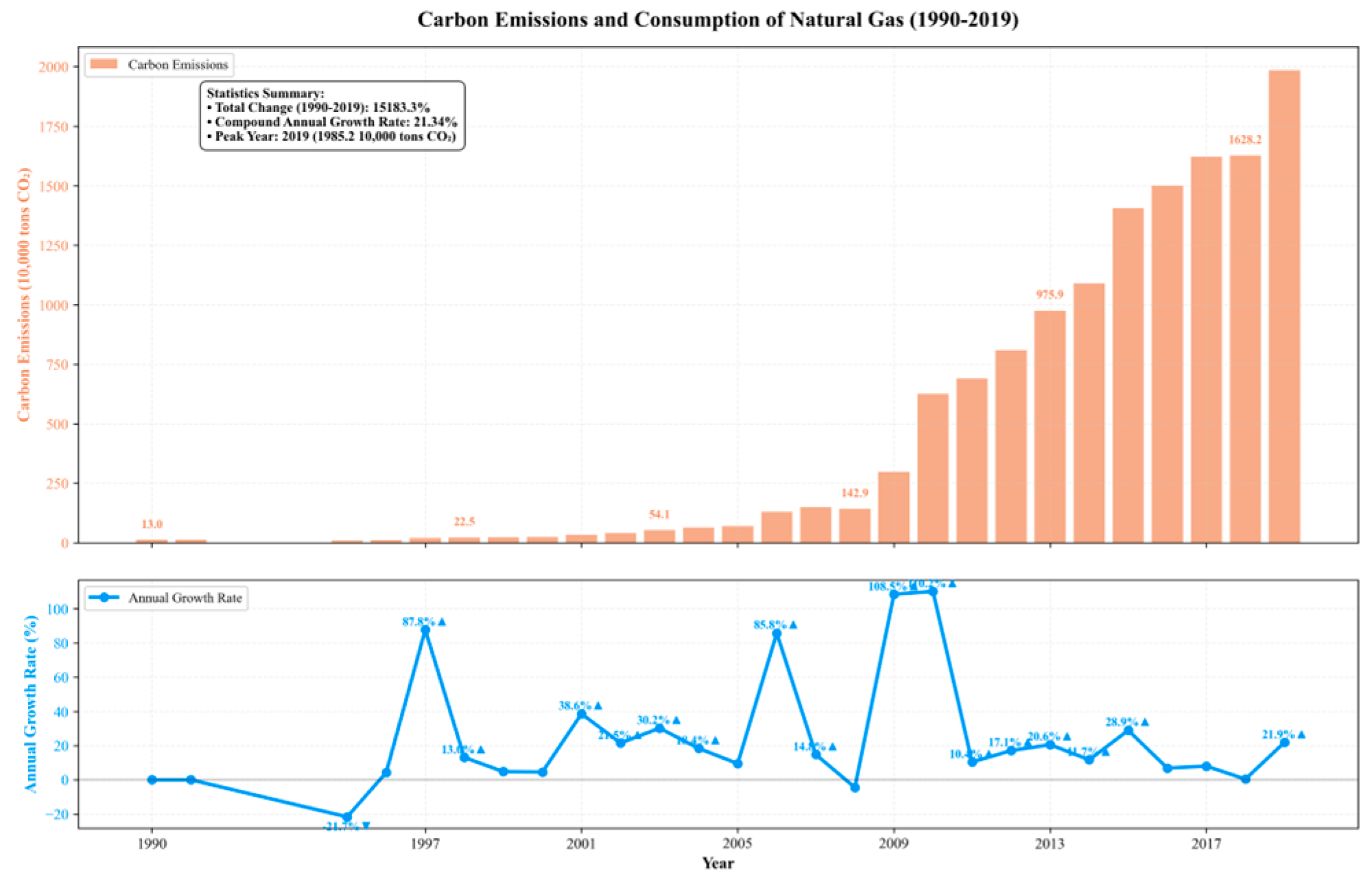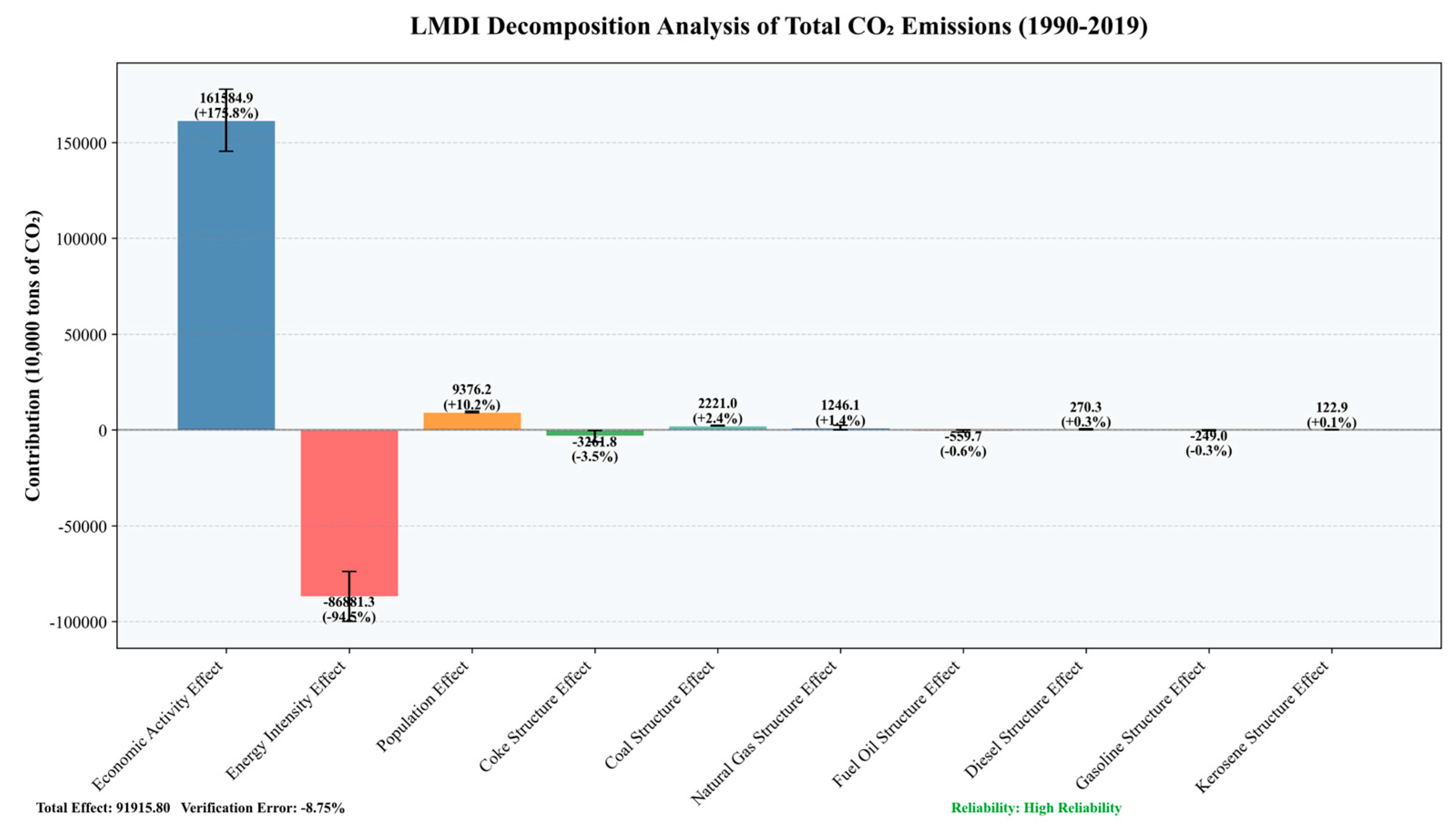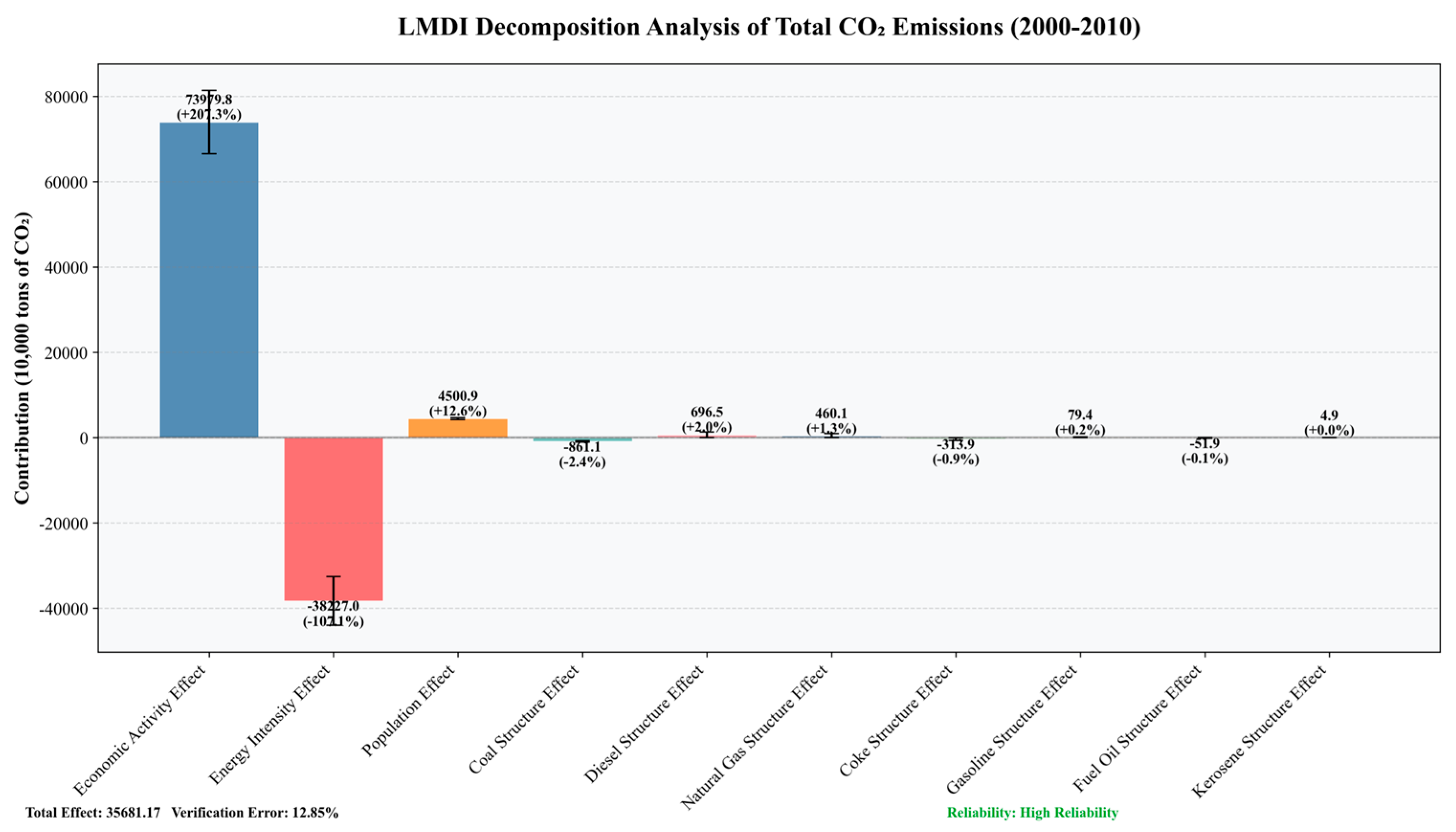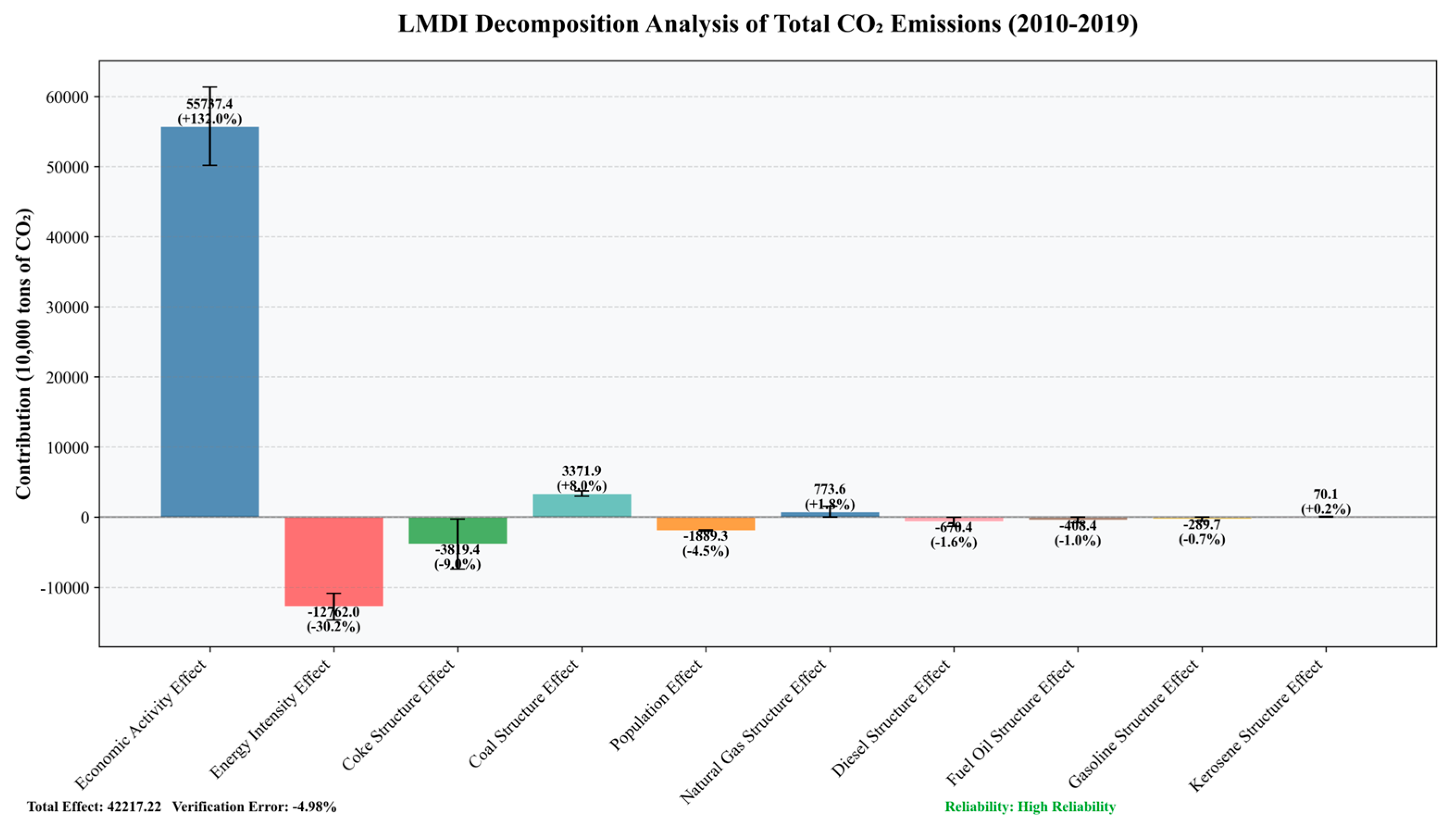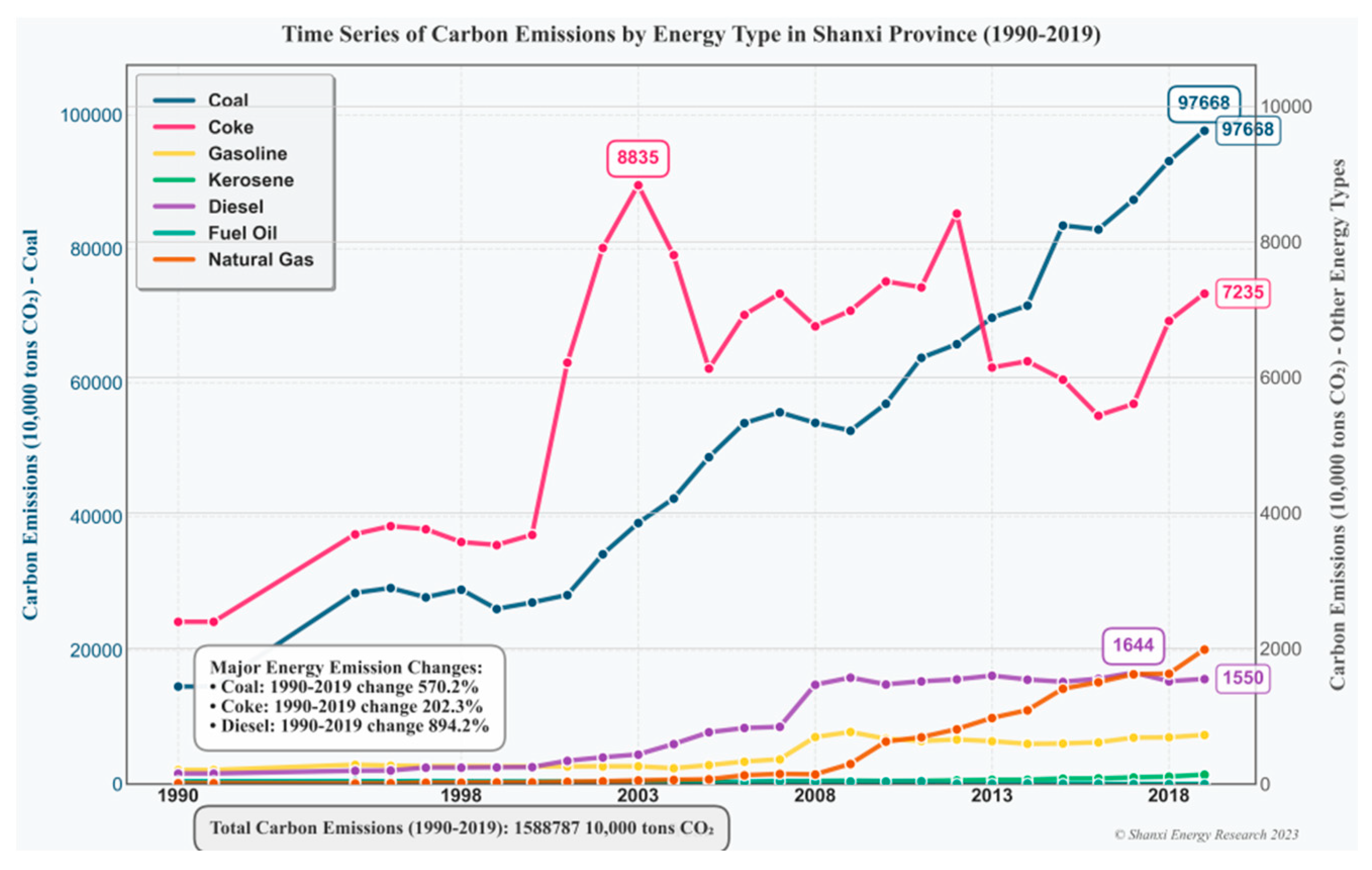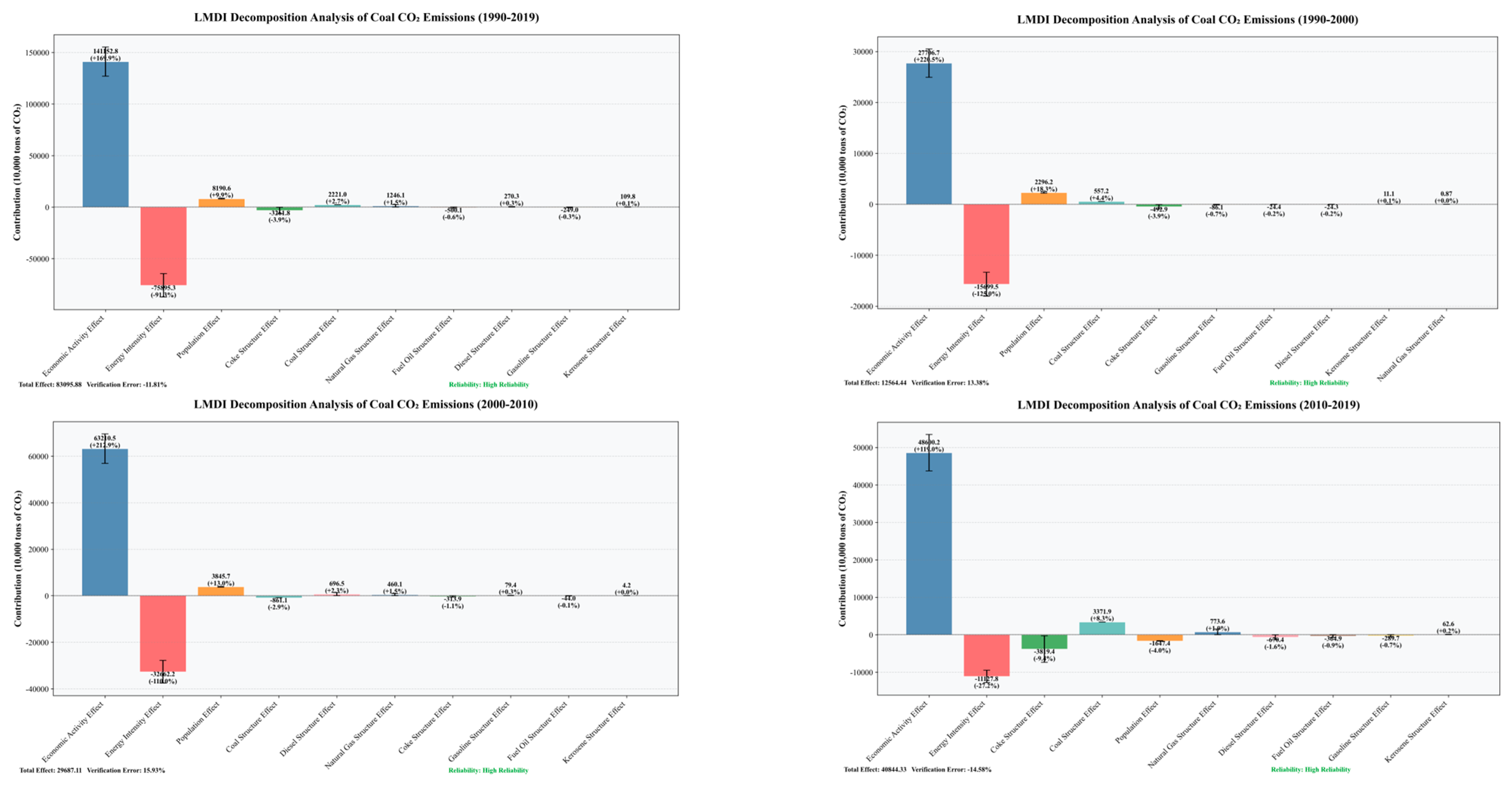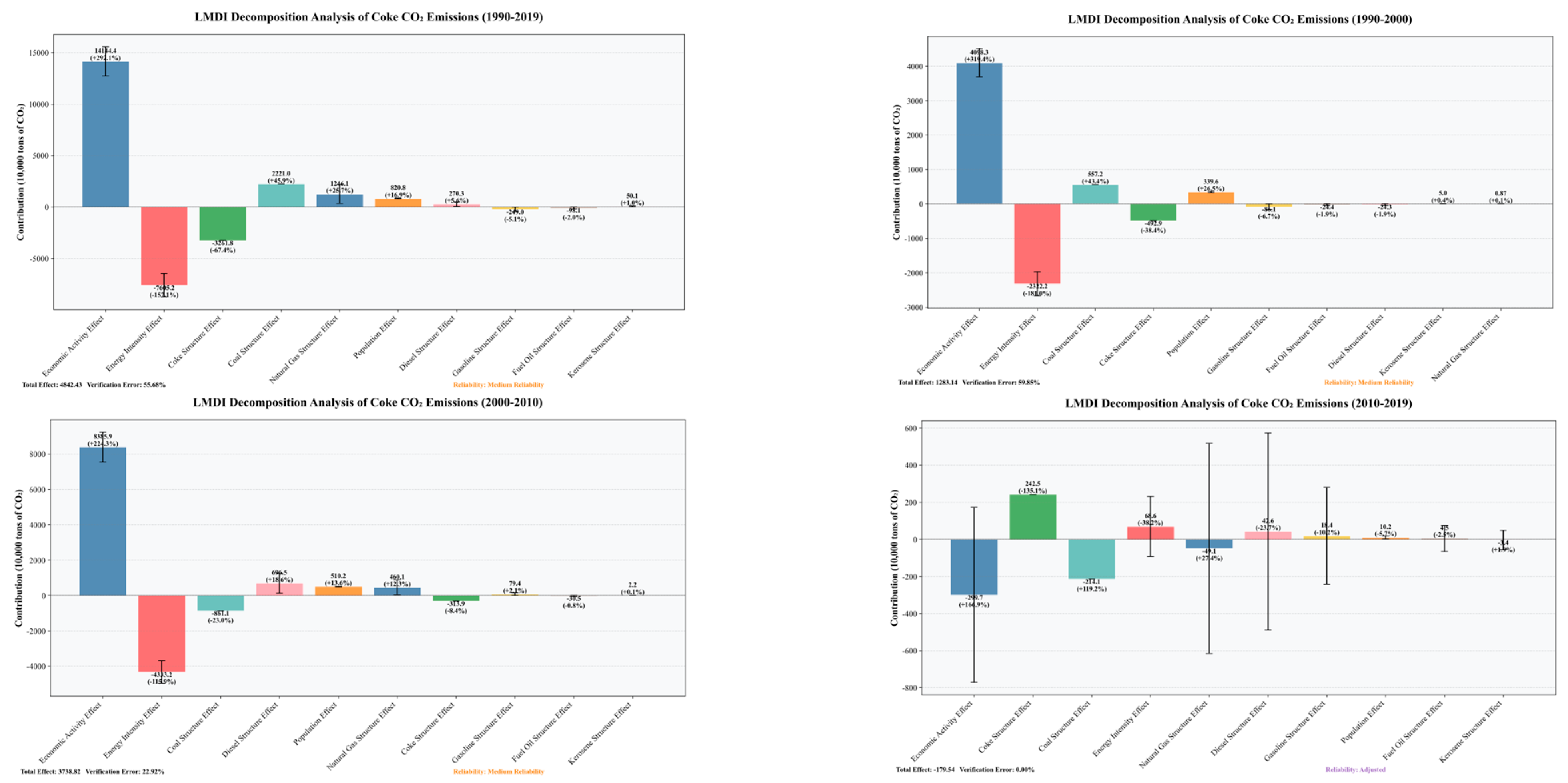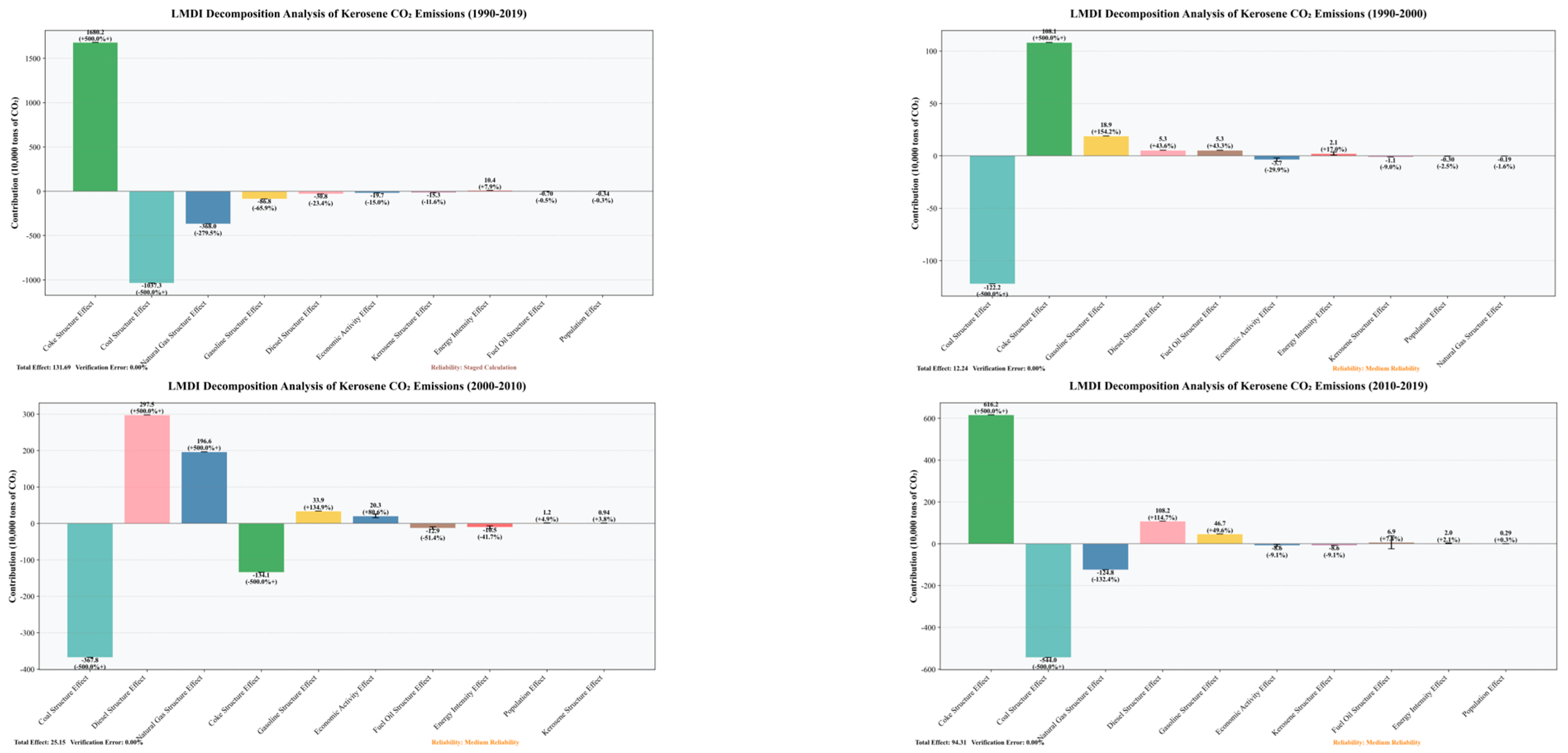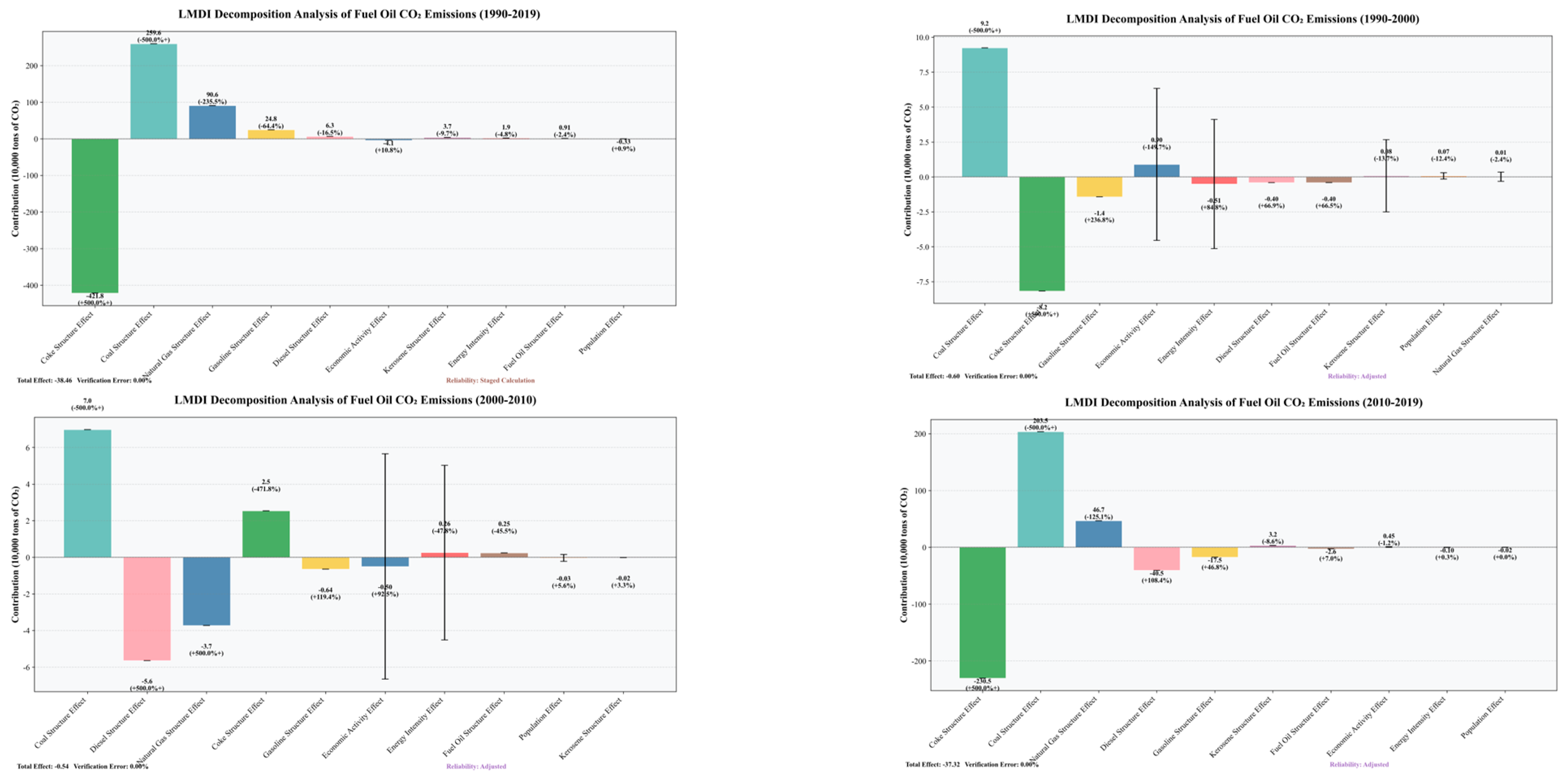1. Introduction
Against the backdrop of global climate change, the continued escalation of carbon emissions has become one of the core challenges facing human society. In the context of the Paris Agreement, which calls for limiting global temperature rise to 1.5 °C, the world needs to achieve net zero emissions by 2050 [
1]. As the world’s second-largest economy, China has pledged to reach peak carbon by 2030 and carbon neutrality by 2060, injecting a strong dose of hope for global climate governance [
2,
3]. However, according to the International Energy Agency (IEA) for 2024, global carbon dioxide emissions have reached 37.8 billion t with fossil energy combustion contributing more than 75 per cent of the emission share [
4]. Against this backdrop, the low-carbon transformation of energy provinces has become the key to China’s fulfilment of its dual-carbon commitment, especially in coal-dependent resource-based regions, where the contradiction between emissions reduction and development is particularly prominent [
5,
6]. Shanxi, as the largest supplier of China’s coal industry, has long ranked first in the country in terms of coal production [
7]. The average share of coal production during the five-year period from 2020 to 2024 is 28.4 per cent of total national production [
8,
9]. The coal-dominated energy mix has driven high-intensity carbon emissions for a long time, while the gradual depletion of coal resources and the intensification of environmental pressures have led to structural dilemmas. How to achieve a low-carbon transition while sustaining economic growth? How do changes in the energy mix drive the trajectory of carbon emissions in Shanxi? These questions not only concern the sustainable development of Shanxi but also provide key perspectives on the low-carbon transition of global resource-based regions.
Research in the field of energy transition and carbon emissions has provided a solid theoretical and empirical foundation for regional low-carbon development. At the macro level, the Kaya equation, the LMDI decomposition model, and the STIRPAT model have been widely used to analyse the drivers of carbon emissions and reveal the interactive effects of economic growth, energy intensity, and energy structure. In view of the complexity and non-linear characteristics of these drivers. At the regional level, scholars have explored the path dependence mechanism of resource-dependent regions, pointing out that coal dependence significantly increases the cost and difficulty of the low-carbon transition through technological and institutional lock-in. They also show that energy efficiency improvements, deployment of wind and renewable energy, and ‘coal-to-gas’ strategies can effectively reduce regional emissions intensity. These studies highlight the unique challenges of energy transitions in resource-dependent regions and provide a basis for a deeper exploration of regional cases.
In the study of carbon emissions in Shanxi Province, the accounting study based on the IPCC Carbon Emission Factor Method quantifies the contribution of emissions from major energy sources, such as coal and coke, and emphasises the emission reduction potential of industrial structure optimisation and energy efficiency improvement [
10,
11]. Scholars also analysed the potential for large-scale application of renewable energy in Shanxi, pointing out that synergies between local financial subsidies and technological innovation are crucial to accelerating the transition [
12,
13]. Recent studies have combined scenario analyses to project long-term carbon emission pathways in Sichuan and Chongqing, emphasising that the active use of clean energy is the key to carbon reduction and emission mitigation [
14]. There are also studies focusing on the supply chain emissions of China’s coal industry, revealing the characteristics of the carbon footprint of the whole chain from mining to end-consumption [
15]. There are also studies that explore community adaptation in the US energy transition from a sociological perspective, analysing the impact of the decline of the coal industry on resource-dependent regions and the acceptance of clean energy policies by community residents [
16,
17]. These studies consistently show that the optimisation of the energy mix is a central driver of the low-carbon transition. However, existing analyses have mostly focused on a single energy type or short-term trends, with less systematic examination of multi-energy synergies, long-term evolutionary patterns, and their combined impact on regional emission trajectories.
At the same time, there are still significant gaps in the theoretical depth and regional applicability of existing studies. First, most of the analyses are conducted from a national or cross-regional perspective, ignoring the resource endowment and policy environment of coal-dependent regions such as Shanxi and failing to reflect the diversification of its energy structure from ‘coal-dominated’ to ‘diversified’. Second, most studies focus on the static accounting of a single energy source and lack a systematic framework to quantify the long-term driving mechanism of carbon emissions from multiple energy sources. Third, the existing literature seldom considers the economic and social constraints of the transition, such as the pressure of employment, the cost of clean energy substitution, and the difficulty of policy implementation, which limits the theoretical depth of the research and the value of practical guidance. These gaps not only limit the depth of academic insights but also weaken the significance of the research in guiding low-carbon practices in Shanxi, especially in the complex context of balancing economic growth and emission reduction targets, where more precise and regionalised analytical tools and empirical evidence are urgently needed.
To address the above gaps, this study takes the energy industry in Shanxi Province as an entry point, aiming to reveal the long-term driving mechanism of multi-energy synergies on carbon emissions and to provide a scientific basis for the design of low-carbon transition paths, and to systematically examine the stage-by-stage characteristics of the energy restructuring and the feedback effects of the policies through the integration of the regionalised decomposition analysis and emission accounting. The contributions of this study include the following:
- (1)
Focusing on the unique context of Shanxi’s energy industry, systematically identifying the synergistic effects of economic, technological, policy, and other multi-drivers on carbon emissions, and providing targeted guidance for the region’s low-carbon transition. Focusing on the energy industry in Shanxi, identify the emission drivers of multi-energy synergies, and propose targeted strategies for regional low-carbon transition.
- (2)
Constructing a dynamic analysis framework for regionalisation, capturing the dynamic inflection points and non-linear effects of the energy structure from coal dominance to diversification, and filling the theoretical gaps in the analysis of multi-energy interactions.
- (3)
The long-term driving mechanisms of multi-energy interactions are analysed, precise emission reduction strategies are proposed to optimise the coal consumption structure and accelerate clean energy substitution, enhance the applicability of the transition scenarios in complex economic and social environments, and provide methodological references for low-carbon practices in other coal-dependent regions around the globe (e.g., Queensland, Australia, Silesia, Poland).
In the urgent context of global climate governance, Shanxi’s transition is not only a regional challenge but also a key piece of the global low-carbon jigsaw. This paper aims to provide scientific guidance for policy makers to promote the historic leap of Shanxi’s energy structure from ‘coal dominance’ to diversification and cleanliness.
2. Methodology and Data
Shanxi is a province with a strong resource endowment, and its coal resource share is in the first place in China, with a coal-bearing area of
, 39.5% of the provincial territory [
18]. At the same time, energy sources such as coke, petrol, and kerosene are also abundant. Based on this background, the analysis of the energy structure of Shanxi Province and the proposal of a comprehensive research method are aimed at comprehensively demonstrating the key elements of the energy transition in Shanxi Province.
2.1. Variable Selection
In order to comprehensively and scientifically reflect the characteristics of the energy structure and the current status of carbon emissions in Shanxi Province, and at the same time, be closely related to the economic development, industrialisation, urbanisation, and living standards of the residents of Shanxi Province. This study has selected the consumption of seven major energy sources in Shanxi Province, namely coal, coke, gasoline, kerosene, diesel oil, fuels, and natural gas, in the last 27 years, which covers the main types of energy consumption in Shanxi Province, with the characteristics of strong data accessibility and scientific accounting, and can provide sufficient samples for long-term trend analysis. At the same time, they can reflect the policy orientation of energy transformation and the correlation between economic and social development, providing strong support for the formulation of reasonable energy policies and emission reduction measures.
2.2. Data Sources
Considering that the use of the LMDI model must be based on the coherence of time series data, and the factor decomposition should reflect the decomposition of carbon emission factors as much as possible, that is, causal identification, since 2019 is the boundary year of the epidemic and the “dual carbon” policy, this paper obtains the data from 1990, 1991, and 1995 to 2019 (1992–1994 due to lack of data, 1990 and 1995) through the Shanxi Provincial Statistical Yearbook. There is no sharp increase or decrease in the degree of annual change in Shanxi Province’s population and regional GDP, and the consumption data of seven major energy sources are collected through the CMSAR database, and based on the development goals such as the “Shanxi Provincial Party Committee Formulates the 2035 Vision and Goals”, the carbon neutrality policy objectives and the actual situation of energy emissions in Shanxi Province are comprehensively analysed to ensure the appropriateness and feasibility of the energy transition pathway. The specific data are shown in
Table 1.
2.3. Technological Route
The technical route of this paper follows the principles of scientific, systematic, and practicality, aiming at comprehensively analysing the trend of carbon emission evolution in the energy industry of Shanxi Province and exploring its sustainable transformation path.
Figure 1 is our roadmap of technology, and the specific research path involves the following:
First, data on the consumption of seven major energy sources in Shanxi Province, including coal, coke, gasoline, kerosene, diesel, fuel oil, and natural gas, are systematically collected for the period from 1990 to 2019. On this basis, the carbon emissions of each energy source are accurately accounted for based on the emission factor method recommended by the Intergovernmental Panel on Climate Change (IPCC), combined with the carbon emission factors of each energy source. This process strictly follows international standards to ensure the scientific validity and reliability of the carbon emission accounting and provides a solid data basis for subsequent model construction and analysis.
Secondly, an analytical model suitable for the characteristics of the energy industry in Shanxi Province is constructed by taking into account the energy use intensity, population size, and gross regional product of Shanxi Province. On this basis, based on Kaya’s constant equation, the LMDI (Logarithmic Mean Divisia Index) model is further constructed, which is a Logarithmic Mean Divisia Index (LMDI) method to decompose the regional carbon emissions using the carbon emission factor model, and the model integrates the economic output, the industry structure, the energy efficiency, the composition of the energy use, and the carbon emission factor’s Influence [
19]. The Kaya Identity is a widely used framework for analysing carbon emissions, which can break down carbon emissions into key factors such as economic activity, energy intensity, energy structure, and population size. This method helps us to gain a deep understanding of the driving mechanisms of carbon emissions and provides a scientific basis for policy-making. The LMDI (Logarithmic Mean Divisia Index) model is a decomposition method based on the logarithmic mean Divisia index, which can quantify the contributions of different factors to carbon emissions. By using this method, we can more accurately analyse the changes in carbon emissions from the energy industry in Shanxi Province and identify the main driving factors.
It is possible to decompose the carbon emissions of Shanxi Province into several key factors, such as economic activity effect, population effect, energy intensity effect, energy structure effect, etc., and to analyse the impact of the seven energy sources on the carbon emissions of Shanxi Province separately. This process not only reveals the degree of contribution of each factor to carbon emissions but also provides a theoretical basis for a deeper understanding of the driving mechanism of carbon emissions in Shanxi Province.
Finally, the model results are systematically analysed, and the evolutionary trends and key influencing factors of carbon emissions from energy industries in Shanxi Province are analysed in depth, taking into account the policy objectives and development plans of Shanxi Province. On this basis, a targeted and feasible low-carbon energy transition path is proposed, aiming to provide scientific decision-making support for Shanxi Province to achieve sustainable development and to ensure that the study can provide practical suggestions for energy transition and carbon emission reduction practices in Shanxi Province.
The steps of the study are divided into four main areas: (1) Collecting the consumption of seven major energy sources in Shanxi Province, namely coal, coke, petrol, kerosene, diesel, fuel, and natural gas, for the past 27 years, and accounting for specific carbon emissions. (2) Considering the energy use intensity, population size, and gross regional product of Shanxi Province, construct a suitable model. (3) On the basis of Kaya’s constant equation, the LMDI model was constructed to separately model the impact of seven energy sources on carbon emissions in Shanxi Province. (4) Analyse the final results of the model to find a suitable energy transition path for Shanxi Province.
5. Conclusions and Recommendations
5.1. Modelling Conclusions
Firstly, the analysis of the model results shows that the economic activity effect is the largest positive driver at all stages, a phenomenon that suggests that the economic development of Shanxi Province is still dependent on high-carbon energy sources, although the province has planned for an energy transition and made significant development concessions for the transition, such as mandatory measures such as the closure of 830 mines [
27]. However, with the advancement of policies, emissions from various industries such as power, transport, and construction, which are the drivers of economic development, are also gradually rising, so that carbon emissions in Shanxi Province remain high due to the impact of other economic activities.
Secondly, energy efficiency improvement is the key to slowing down carbon emissions. Through data analysis, it can be found that the energy intensity effect is the most important negative factor, which indicates that technological progress and energy efficiency improvement play an important role in controlling carbon emissions, and that in recent years, improving ‘urban resilience’ has been regarded as a major strategic pathway to promote sustainable urban development. Strategic Path [
28]. Energy, as an important part of urban development, on the one hand, involves energy transition; on the other hand, it acts on the use of energy. Energy intensity in Shanxi Province is declining year by year, indicating that the quality of GDP development in Shanxi Province is becoming increasingly cleaner and de-energised development.
On the other hand, the impact of changes in the energy structure has gradually come to the fore, and after analysing the data, it can be found that the proportion of coal in the energy structure is still high and has increased in recent years, while the proportion of coke in the energy structure has significantly declined, and the proportion of natural gas and clean energy in the energy structure has continued to increase, reflecting the trend of the energy structure towards cleaner energy.
Finally, changes in population also have an impact on carbon emissions, with the population effect turning negative for the first time in the 2010–2019 period, suggesting that demographic factors are beginning to dampen carbon growth, which is closely linked to China’s economic development and socio-demographic conditions, such as declining fertility rates and rising ageing, and other socio-demographics.
5.2. Suggestion
- (1)
Promoting industrial upgrading and economic transformation:
Reducing the dependence of economic growth on high-carbon energy and developing low-carbon industries and services requires a multifaceted approach. On the one hand, the government should formulate and improve relevant policies and regulations and guide enterprises to reduce their dependence on high-carbon energy by means of tax incentives and financial subsidies, etc.; at the same time, it is necessary to set up and improve the system of personnel training and strengthen the construction of relevant professional disciplines, enhance the co-ordinated development of the region, and develop a differentiated industrial development strategy in different regions according to their own advantages. Different regions should formulate differentiated industrial development strategies according to their own advantages; economically developed regions should develop high-end low-carbon industries and modern service industries, and central and western regions should pay attention to green transformation in undertaking industrial transfers, actively participate in global climate governance, strengthen international cooperation, introduce foreign advanced technology and experience, enhance the competitiveness of low-carbon industries in Shanxi Province, jointly respond to the challenges of climate change, and promote the sustainable development of the economy.
- (2)
Improving energy efficiency:
In order to continue to improve energy efficiency, enterprises need to increase the research and development and application of energy-saving technologies, promote advanced energy-saving technologies and equipment, optimise energy management and production processes, and further improve the efficiency of energy use so as to effectively reduce energy consumption per unit of GDP and promote the sustainable development of the economy and society.
- (3)
Optimisation of energy structure:
Each energy industry should control the total consumption of coal, improve the level of clean coal use accelerate the development of natural gas and other clean energy, and at the same time, renewable energy sources, such as wind and solar energy, technology and policy support, training of relevant professionals, and the establishment of a professional R&D team, dedicated to the development and transformation of the energy industry.
- (4)
Promoting low-carbon lifestyles:
Guiding residents to form low-carbon consumption habits and fully tapping the low-carbon potential of individual residents [
29]. Reduce per capita carbon emissions through green actions such as promoting a low-carbon lifestyle for all.

